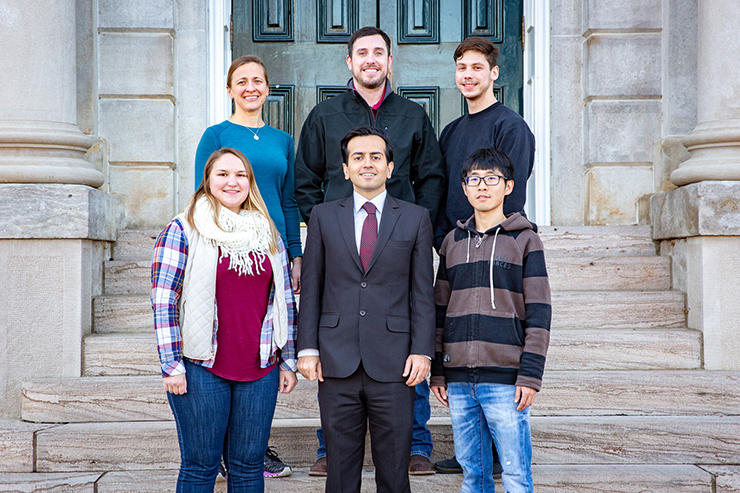U.S. Army Funds Research on Nanoporous Materials for Water Purification

This image illustrates how Hudson Beyzavi proposes to use nanopourous structures to remove contaminants from drinking water.
Contaminants from munitions can make their way into our water supply through runoff, and they are surprisingly common pollutants. Hudson Beyzavi, an assistant professor in the Department of Chemistry and Biochemistry, is investigating the use of nanoporous structures to detect and remove these contaminants in water. His research is supported with an award from the U.S. Army Small Business Innovation Research (SBIR) Program.
Beyzavi explained that these types of pollutants can cause serious problems for humans, plants and animals.
"These chemicals are significant groundwater and industrial wastewater contaminants in both the United States and European Union." Beyzavi said. "The success of this research project will significantly aid in the advancement of removal technology for toxic compounds in drinking water and soil."
The Beyzavi Laboratory is working with a local startup company, CatalyzeH2O, LLC. CatalyzeH2O was founded by Shelby Foster, a graduate student in chemical engineering, and Lauren Greenlee, an assistant professor in the Ralph E. Martin Department of Chemical Engineering.
Beyzavi and CatalyzeH2O are investigating the design, synthesis, and application of covalent organic frameworks, which are a type of nanoporous material. Nanoporous materials have attracted wide attention owing to their ability to interact with atoms, ions, and molecules. Because of their molecular structure, covalent organic frameworks can serve as building blocks for making predesigned, robust materials in an unprecedented way. They can be used for various applications, including ion exchange, catalysis, sensor applications, biological molecular isolation and purification, gas storage and separation.
The U.S. Army SBIR program is a congressionally mandated program coordinated by the Small Business Administration. The U.S. Army SBIR Program's mission is to elicit innovative solutions from the small business community that address defense technology gaps confronting the Army and to include technologies that will also have high commercialization potential in the private sector.

Back row, from left: Lauren Greenlee, assistant professor of chemical engineering and CTO of Catalyze H20; Derek Hess, chemical engineering undergraduate student; and Joseph Duffield, chemistry graduate student. Front row: Shelby Foster, chief executive officer of Catalyze H20; Hudson Beyzavi, assistant professor of chemistry; and Jiyun Hu, postdoctoral researcher.
Topics
Contacts
Camilla Shumaker, director of science and research communications
University Relations
479-575-7422,
camillas@uark.edu
Headlines
PetSmart CEO J.K. Symancyk to Speak at Walton College Commencement
J.K. Symancyk is an alumnus of the Sam M. Walton College of Business and serves on the Dean’s Executive Advisory Board.
Faulkner Center, Arkansas PBS Partner to Screen Documentary 'Gospel'
The Faulkner Performing Arts Center will host a screening of Gospel, a documentary exploring the origin of Black spirituality through sermon and song, in partnership with Arkansas PBS at 7:30 p.m. Thursday, May 2.
UAPD Officers Mills and Edwards Honored With New Roles
Veterans of the U of A Police Department, Matt Mills has been promoted to assistant chief, and Crandall Edwards has been promoted to administrative captain.
Community Design Center's Greenway Urbanism Project Wins LIV Hospitality Design Award
"Greenway Urbanism" is one of six urban strategies proposed under the Framework Plan for Cherokee Village, a project that received funding through an Our Town grant from the National Endowment for the Arts.
Spring Bike Drive Refurbishes Old Bikes for New Students
All donated bikes will be given to Pedal It Forward, a local nonprofit that will refurbish your bike and return it to the U of A campus to be gifted to a student in need. Hundreds of students have already benefited.




